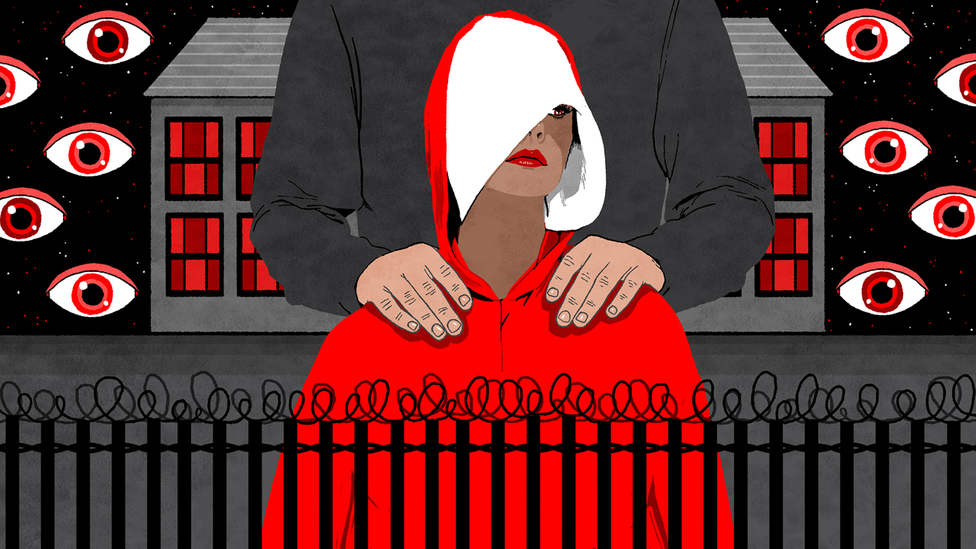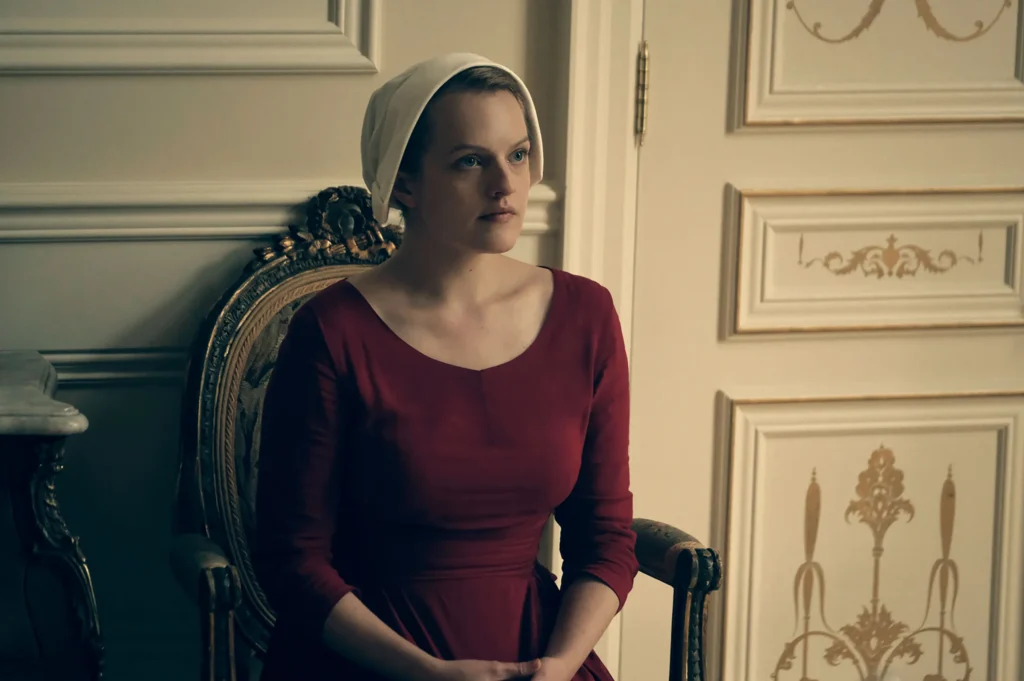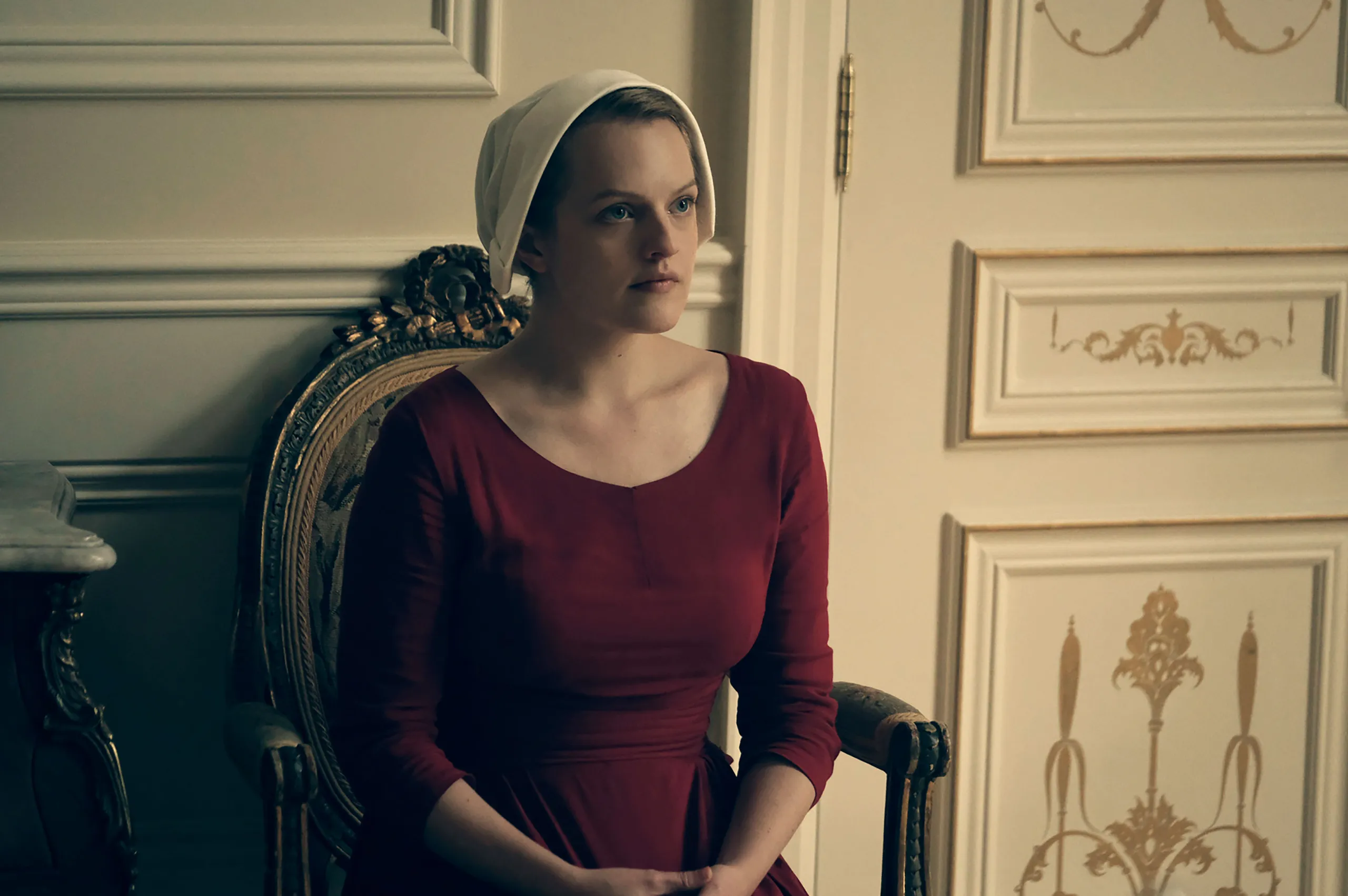Learn what the panopticon is and why it plays such an important role in oppressing the women of Gilead in Margaret Atwood’s The Handmaid’s Tale.
Originally published in 1985, The Handmaid’s Tale has been part of countless controversies ranging from book burnings to bans against the book in several countries, including Spain and Portugal, for being anti-Christian and propagating physical and sexual violence. What makes it so sensational and relevant? Well, in The Handmaid’s Tale, Atwood pens a cautionary tale exploring how a flawed utopia paves a path for totalitarian dystopias.
Here, we witness a world where the government of the United States is deprived of its power due to the arrival of a theonomic group called The Republic of Gilead. The new political power strips away people from their possessions and bifurcates them by dividing them into gender first and then assigning specific roles to each gender. In Gilead, the role of an individual can be ascertained by what kind of uniform they wear – red is for the handmaids (surrogates), blue is for the wives, green is for the Marthas (Econowives), and brown is for the Lydias (supervisors).
The novel addresses the evils of patriarchal structures and how they impact men and women alike. In this essay, I will explore how Atwood drew upon the idea of the panopticon and female surveillance by talking about the recurring motif of the ‘eye’ in the novel.
But before we begin, here’s a little something that you should know about the author of the book.

About Margaret Atwood
Margaret Eleonor Atwood is a Canadian author, poet, and literary critic. She is known for her contributions to prose fiction, speculative fiction, and satire. Her works mainly create a space for highlighting issues like sexual oppression, inequality and claustrophobia. The Edible Woman (1969), Atwood’s first novel, introduced her scalding prose – delineating a woman’s suffocation by depicting her as someone being eaten by people around her – to the world.
Many of Atwood’s works have been adapted to visual media, the most well-known among them being Hulu’s adaption of The Handmaid’s Tale (2017). Her books and poems have been translated into numerous languages, such as Spanish, French, Italian, and Russian. She won a man booker price twice, first in 2000 for the novel Blind Assassin (2000) and the other in 2019 for a sequel to The Handmaid’s Tale called The Testaments (2019). Her most recent publication is a short story anthology called Old Babes in the Wood (2023) which feature seven short stories reflecting the nature of human bonds.
What is Panopticon, and How are Women in Gilead the Victims of the Same?
The word panopticon is derived from the words ‘pan’ meaning ‘all’ and the Greek word ‘optikos’, meaning vision. Jeremy Bentham, a social theorist and English philosopher, came up with the design and concept of the panopticon, which refers to a circular prison through which one party is placed under 360° surveillance by another party. This architectural feat facilitates a network wherein guards can always see the prisoners but the latter cannot see the former.
However, with time, the concept of the panopticon converted into a phenomenon, with several writers and theorists, including Foucault, talking about it. In Atwood’s novel itself, this idea is reflected through the scrutinising eyes littered everywhere – from material eyes like that of Lydia’s to the ‘eye’ of God that is watching over the people of Gilead all the time. The narrative allows us to witness how the fear of being constantly watched by someone stops the Handmaids from speaking out or running away from their oppressive conditions. This fear is claustrophobic, and it operates by creating an illusion of 360-degree surveillance, just like the structure of the panopticon does. In fact, the structure makes the handmaids start to police themselves by creating a mental prison that would stop them even from thinking about escaping.
Atwood describes eyes in various ways throughout the novel, including the act of combining God and religion to surveillance. The terror of the ‘eye’ is propagated in the form of a greeting. For example:
“Under His Eye,” she says. The right farewell.
“Under His Eye,” I reply, and she gives a little nod.
With something like the all-seeing eye of Sauron (Remember, the Lord of the Rings?) always on the mind of the subjects in Gilead, even the conception of ideas attempting to overthrow authority becomes impossible for them. The government of Gilead thrives by keeping the opposition, especially the women, under this panopticon vision by holding them mentally, spiritually and verbally hostage. This, in turn, makes them inept in the socio-political sphere of life. The motif of the ‘eye’, therefore, is recurring in the narrative, where terror and surveillance are interrelated, and they complement each other. The Handmaids in Gilead are only scared of the ‘eye’, but they function as an eye for their selves, facilitating the government to keep their actions in check. The terror of the ‘eye’ keeps them oppressed and resists any protests from their end.
In Gilead, women are on lockdown as if they are under a penitentiary institution; they are not allowed to go out, wear what they want, take care of their skin, and eat the food of their choice. They are also denied the privilege of news, television or any active source of knowledge and are not allowed to read or write in order to detach and immobilise their intellectual growth; women are denied the right to live or to end their life in Gilead because there they are made to live to produce.
The manipulating and fear-mongering mechanisms provide a helping hand in dismantling the agency of women and creating a gulf between victim women. The defiant women and men are abused physically and used as cautionary examples that prevent resistance from rising, the scene where a handmaid Moria tries to run away and is thoroughly punished is an instance where someone who challenges the authority is put on public display so that others would refrain themselves from trying the same and would check their actions since eyes are everywhere no one can escape them,
Moira lay on her bed, an example. She shouldn’t have tried it, not with the angels, Alma said, from the next bed over.
Also Read: The Importance of Anne Frank’s Diary in Understanding the Holocaust
How Does The Handmaid’s Tale Allude to Reality?

Atwood’s Handmaid’s Tale is petrifying because it stands the test of time. It is not merely dystopian ‘fiction’ but is inspired by several real-life incidents that together create a horrific vision of our present. The premise of the novel is inspired by incidents like the Salem witch Trials, public executions, biblical surrogacy, and so on. With the new abortion policies in the USA, we can witness the materialization of Gilead in our own world.
Few Examples of Real-life Parallels of Gilead
- Baby farms in the 19th century: The emergence of baby farms, also known as baby factories, in the 19th century, chronicles a series of pregnancies wherein women would be forced to give birth and then have their snatched from them and sold. This idea lies at the heart of the new political regime in Gilead.
- Hijab in Iran, Headscarves in The Handmaid’s Tale: The dress of handmaids with the headscarves and flaps that hide their face and the formless whole of the cloth that covers them from head to toe has close similarities with the strict Islamic laws of mandatory Hijab in Iran and other countries.
- Public executions of women: In the 17th, 18th, and 19th centuries, public executions were common in the United States. Examples can be drawn from the Salem witch trials and the infamous Mary Surratt, who was accused of conspiring with John Wilkes Booth in an assassination plot against Abraham Lincoln. In Gilead, too, public executions are common as they serve the purpose of inducing fear. In fact, there is a specific wall in Gilead where all the victims of these executions are put on display.
Summing up
The relevance of The Handmaid’s Tale in contemporary times is unparalleled since several countries are headed by governments that believe in the panopticon vision. The new form of oppression is at the forefront where the idea of the newly acquired equality is more important than the inherent and inexcusable inequality that still exists and will continue to exist, especially if we will try to stifle the dissent by policing ourselves with the misguided newly found notions of equality.

